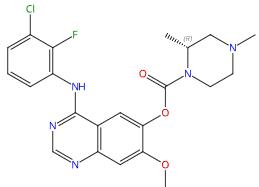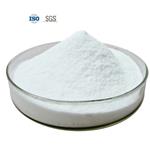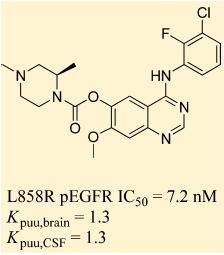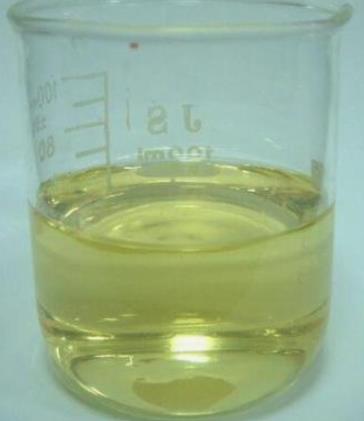The Applications and Mechanism of Action of AZD 3759
General description
AZD3759 represents a novel small molecule inhibitor targeting the epidermal growth factor receptor (EGFR) tyrosine kinase, designed specifically to address non-small cell lung cancer (NSCLC) that have become resistant to first-generation EGFR inhibitors, such as gefitinib and erlotinib. In preclinical evaluations, AZD3759 has shown favorable pharmacokinetic profiles, including effective oral bioavailability and the capability to penetrate the blood-brain barrier. This characteristic is particularly crucial given the prevalence of brain metastases in NSCLC patients, especially those with EGFR mutations. Ongoing clinical trials are assessing the safety and efficacy of AZD3759 in individuals with advanced NSCLC, with early results indicating significant anti-tumor activity alongside manageable adverse effects. Consequently, AZD3759 emerges as a promising therapeutic candidate for further exploration within the challenging context of this disease, owing to its distinct mechanism of action and advantageous pharmacokinetic properties.

Figure 1: Structural formula of AZD 3759
Applications
The Clinical Applications of AZD 3759 in the Treatment of Non-Small Cell Lung Cancer. AZD 3759 represents a significant advancement in the treatment of Non-Small Cell Lung Cancer (NSCLC), particularly benefiting patients harboring specific EGFR mutations and those with brain metastases. This innovative therapy transcends the limitations of traditional chemotherapy and radiation, introducing a new realm of hope for cases where these conventional methods fall short.
Targeted Therapy for EGFR Mutations
The cornerstone of AZD 3759's utility is its precision in targeting NSCLC cells with EGFR mutations. These genetic variations, prevalent among a substantial subset of NSCLC patients, play a crucial role in the cancer's development and progression. By inhibiting the activity of the mutant EGFR tyrosine kinase, AZD 3759 heralds a transformative approach to cancer treatment. It signifies a move toward personalized medicine, focusing on the genetic basis of the disease.
Overcoming the Blood-Brain Barrier
A paramount challenge in NSCLC management is addressing brain metastases. These are not only common but also notoriously difficult to treat due to the protective blood-brain barrier (BBB). The ability of AZD 3759 to efficiently penetrate the BBB enables it to reach and affect tumor cells within the brain, overcoming a significant hurdle faced by many therapeutic agents. This capability considerably broadens the spectrum of treatment options for patients with advanced NSCLC, offering a targeted strategy to address both the primary lung tumors and their central nervous system metastases.
Redefining NSCLC Treatment Paradigms
The introduction of AZD 3759 into clinical settings has instigated a shift in the treatment paradigms of NSCLC. It proves especially advantageous for patients who have developed resistance to first-line EGFR tyrosine kinase inhibitors (TKIs) or those diagnosed with CNS involvement. By providing a targeted and effective treatment alternative for these complex scenarios, AZD 3759 enhances the overall survey.
Mechanism of Action
AZD 3759 is a potent, orally bioavailable inhibitor that targets the Epidermal Growth Factor Receptor (EGFR), a key factor in the development of Non-Small Cell Lung Cancer (NSCLC). Its mode of action involves inhibiting the activity of EGFR tyrosine kinase, which is frequently overactive in NSCLC due to specific mutations in the EGFR gene. These mutations trigger unchecked cell growth and survival, aiding in tumor development and advancement. A distinctive feature of AZD 3759 is its capacity to traverse the blood-brain barrier (BBB), addressing a major obstacle in treating NSCLC patients with brain metastases. By crossing the BBB, AZD 3759 ensures therapeutic levels are attained within the central nervous system (CNS), aiming at both primary lung tumors and brain metastases. Upon reaching its target, AZD 3759 attaches to the ATP-binding site of the mutated EGFR tyrosine kinase, blocking its function. This inhibition stops the phosphorylation of downstream signaling molecules, effectively ceasing the signaling pathway that promotes cell division and growth. Consequently, this halts the proliferation of cancer cells and triggers apoptosis (programmed cell death). This targeted strategy not only facilitates effective NSCLC management but also limits the impact on healthy cells, diminishing the likelihood of adverse effects typically associated with cancer therapies. The specificity of AZD 3759 in targeting EGFR mutations, together with its capability to reach brain metastases, represents notable progress in NSCLC treatment options, providing new hope for patients in advanced stages of the disease.
References
[1]Wu, Qingjun, et al. "Determination and pharmacokinetic study of AZD‐3759 in rat plasma by ultra-performance liquid chromatography with triple quadrupole mass spectrometer." Thoracic Cancer 9.11 (2018): 1383-1389.
[2]Wu, Qingjun, Ailian Hua, Yaoguang Sun, Chao Ma, Wenxin Tian, Chuan Huang, Hanbo Yu, et al. "Determination and pharmacokinetic study of AZD‐3759 in rat plasma by ultra performance liquid chromatography with triple quadrupole mass spectrometer." Thoracic Cancer 9, no. 11 (2018): 1383-1389.
Related articles And Qustion
Lastest Price from AZD 3759 manufacturers

US $0.00/kg2025-03-07
- CAS:
- 1626387-80-1
- Min. Order:
- 1kg
- Purity:
- 0.99
- Supply Ability:
- 20tons

US $0.00/g2025-01-13
- CAS:
- 1626387-80-1
- Min. Order:
- 1g
- Purity:
- More Than 99%
- Supply Ability:
- 100kg/Month




